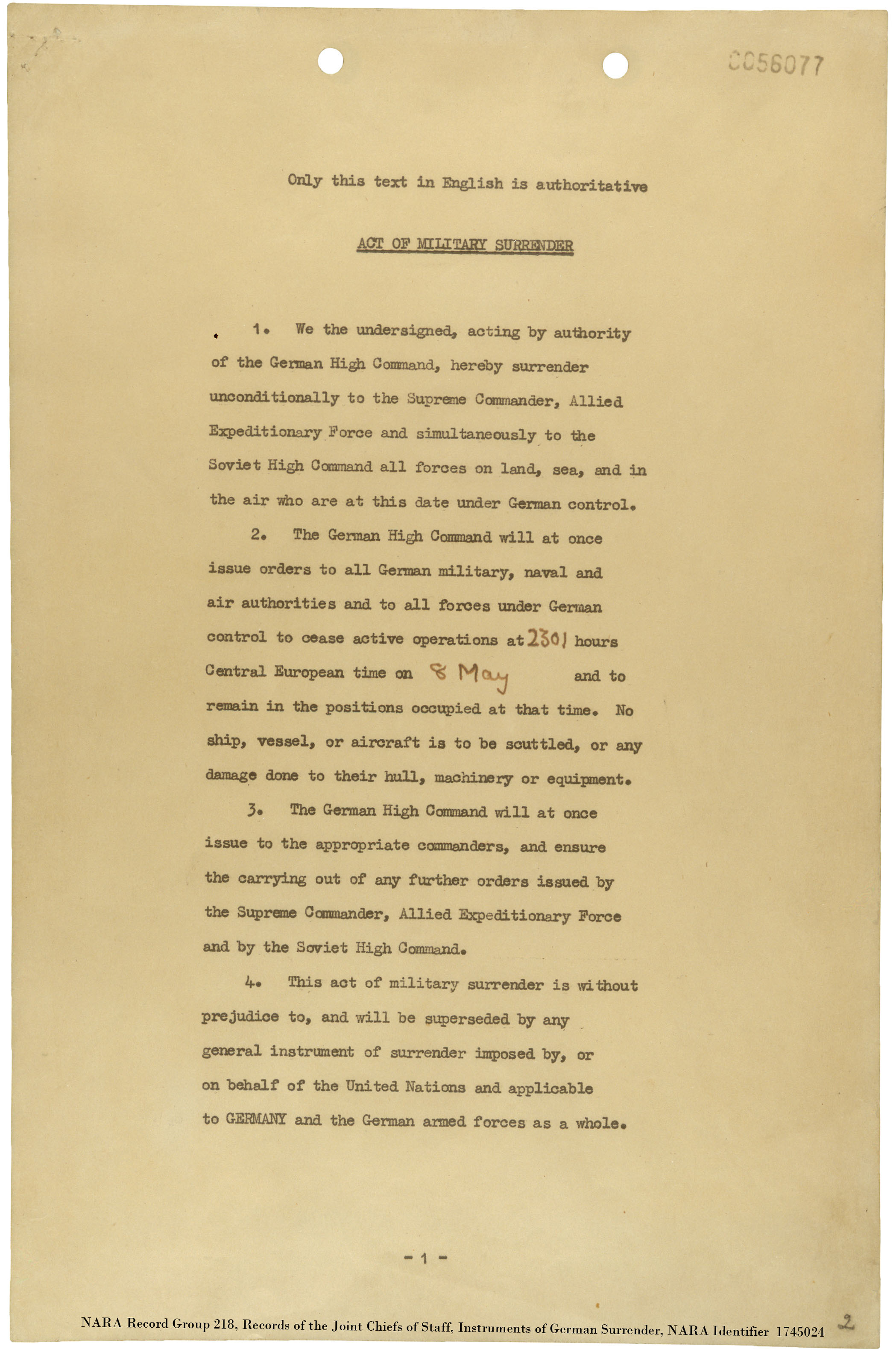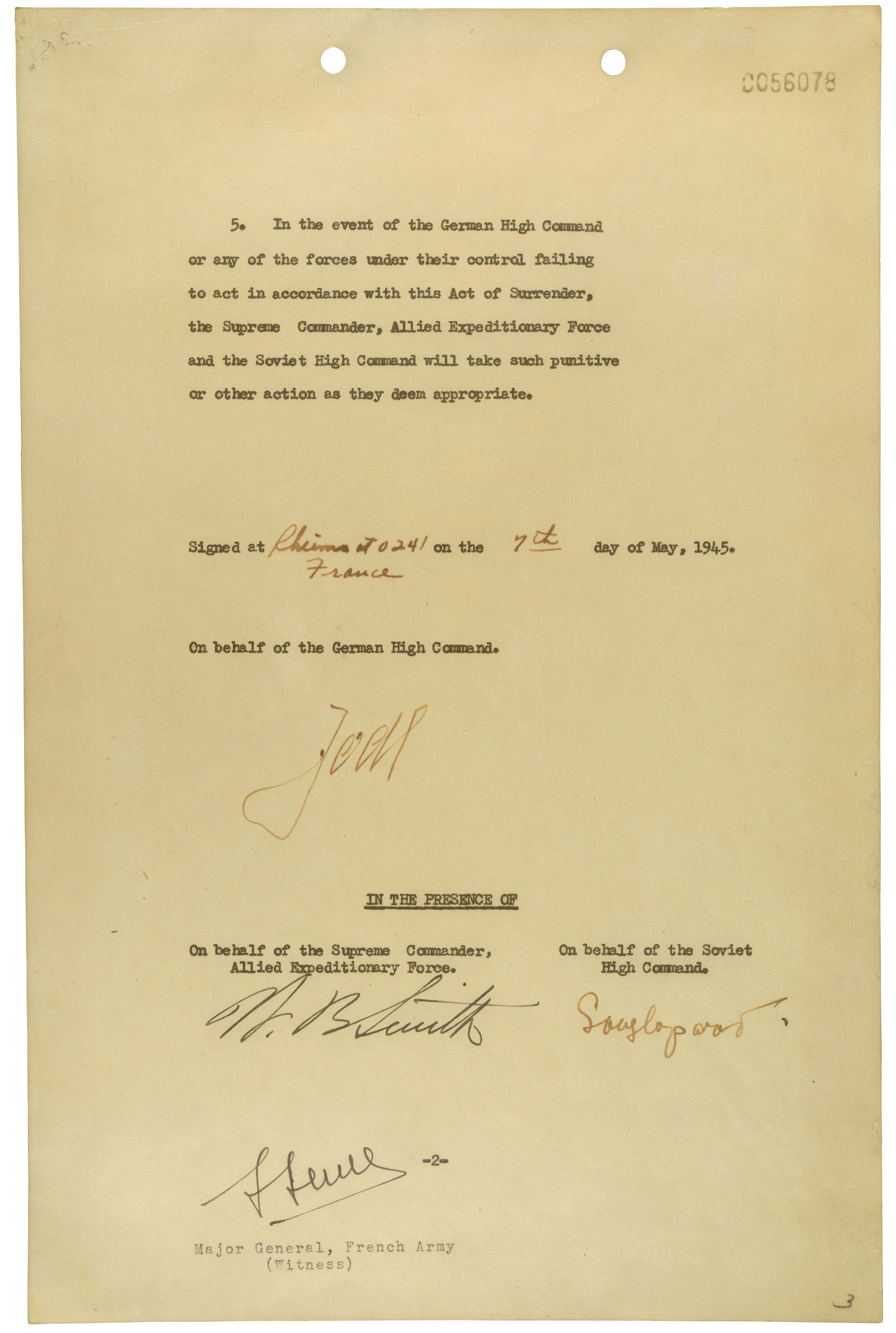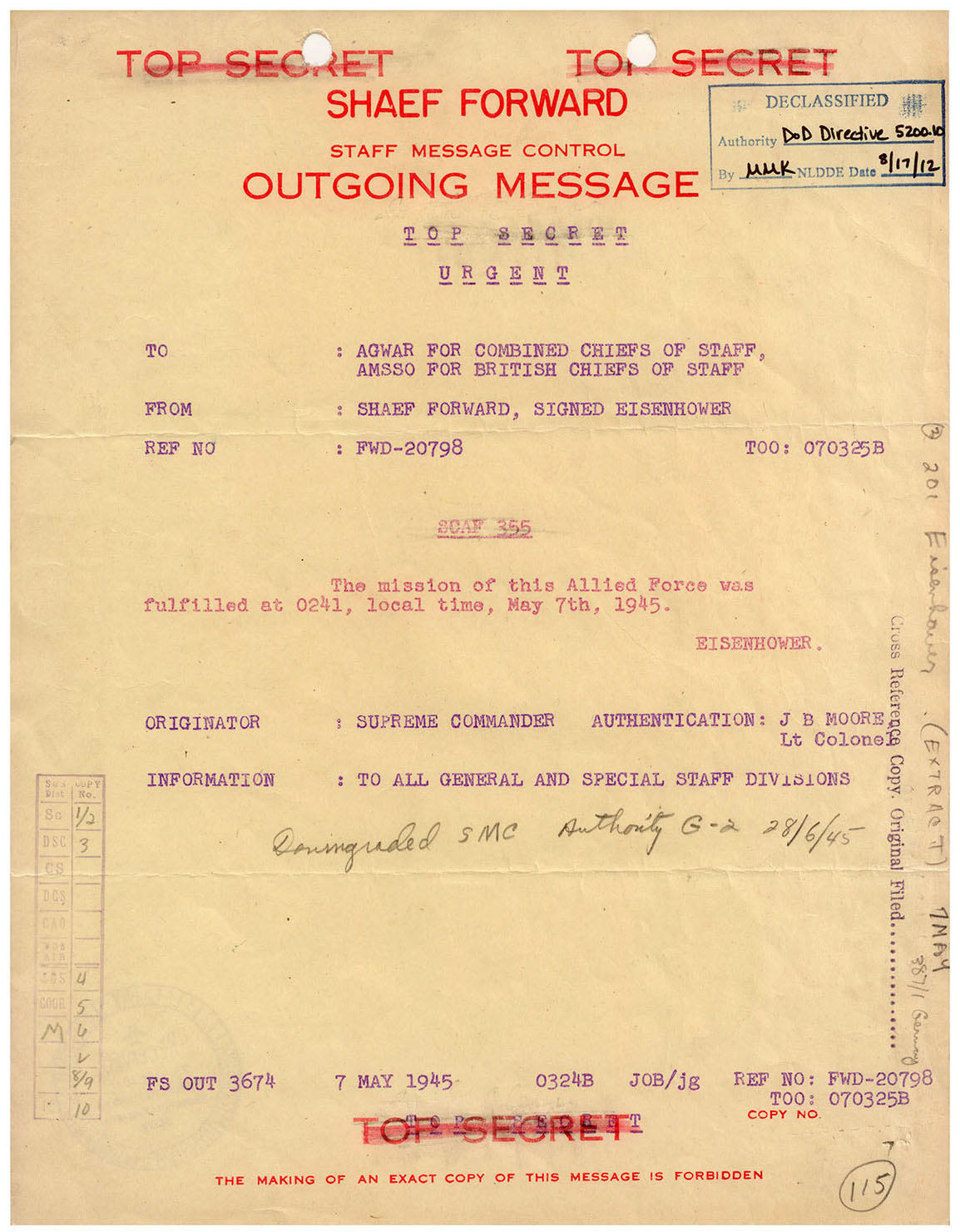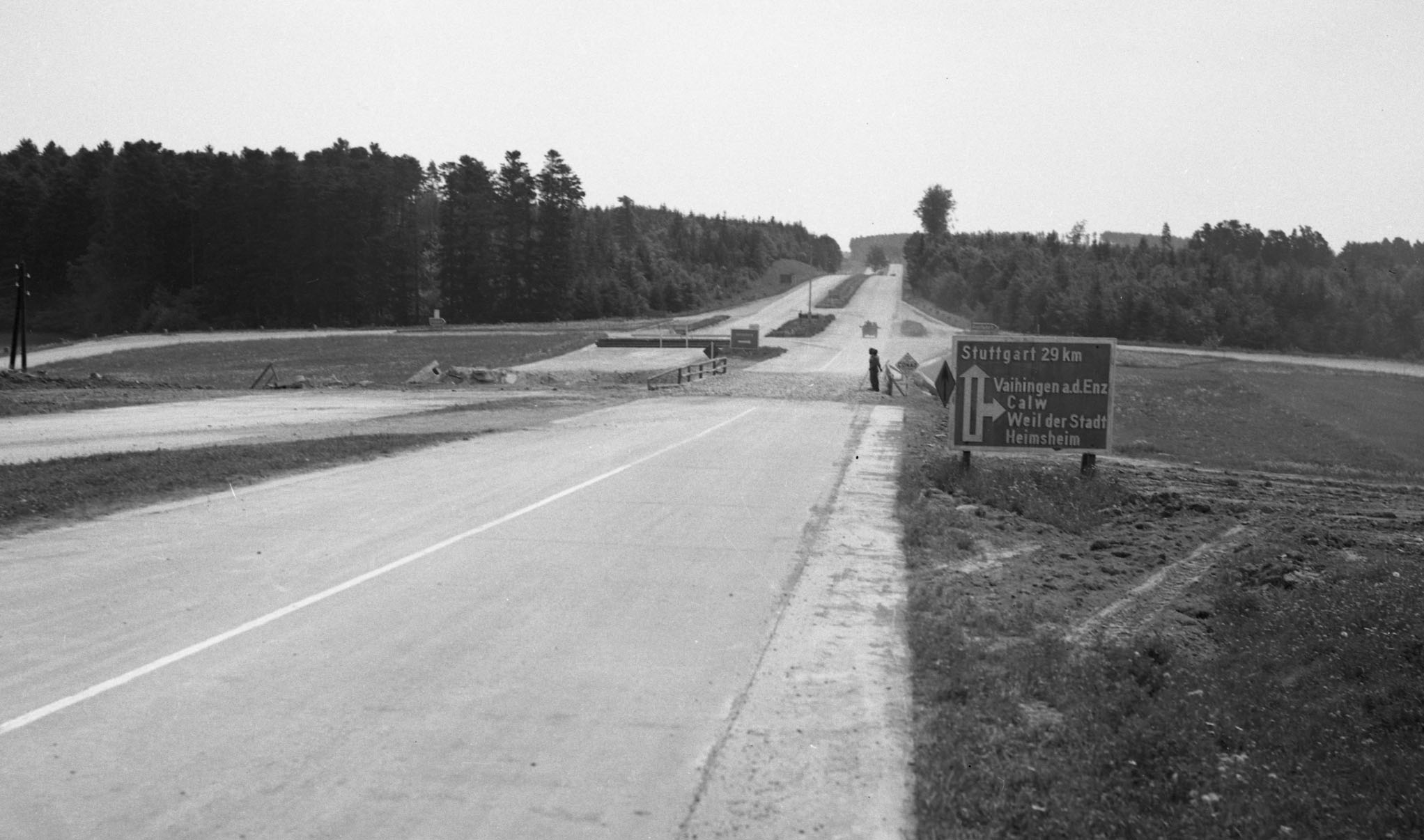In the early morning hours of 7 May 1945, Allied soldiers ushered German General Alfred Josef Ferdinand Jodl, Chief of the Operations Staff for the German High Command, and a small entourage into a room at Supreme Headquarters, Allied Expeditionary Forces in Reims, France. On the walls of the cramped room were charts showing casualty numbers and maps that depicted the Allied advance across Europe. The space was overcrowded with nearly sixty military and press personnel who were present to witness an event that belied the workroom atmosphere of their surroundings. General Jodl arrived with authority from Admiral Karl Dönitz, Adolph Hitler’s successor, to execute the terms of surrender of German forces. Jodl placed his signature on a simple typed document that surrendered all German forces on land, sea, and air to Allied Forces. General Walter Bedell Smith accepted on behalf of the Supreme Commander, Allied Expeditionary Force and General Ivan Susloparov on behalf of the Soviet High Command.
A few doors down, Supreme Allied Commander-Europe General Dwight D. Eisenhower waited in his office, where soldiers escorted the German officers after signing. General Eisenhower asked if they understood the unconditional terms and if they were prepared to carry them out. Two brief nods signified they did. They turned and walked out. Six years after the start of the war in Europe, and eleven months after the D-Day invasion and a relentless march across the continent by Allied forces, the war in Europe was officially over.
 |
 |
|
This is the unconditional surrender of all German forces to the Supreme Allied Commander, Allied Expeditionary Force and Soviet High Command, in which all German military operations would cease on May 8, 1945, at 2301 hours. It is signed by Generaloberst Alfred Jodl on behalf of the German High Command, Walter B. Smith on behalf of the Allied Expeditionary Force, and Ivan Susloparov on behalf of the Soviet High Command at Reims, France.
NARA, Record Group 218: Records of the U.S. Joint Chiefs of Staff, 1941 – 1977. National Archives Identifier 1747981.
|
 |
|
The officers around Eisenhower tried out several grand statements, hoping to come up with words worthy of the momentous occasion. The final message came from the Supreme Commander himself—in typical concise, straightforward style. Courtesy of the Dwight D. Eisenhower Presidential Library
|
V-E (Victory in Europe) Day was the culmination of efforts that began in early spring 1941 when a small contingent of U.S. Army officers arrived in England to coordinate plans in the event the U.S. would enter the war. The engineer officer who joined this Special Observer Group (SPOBS) was Lt. Col. (later Maj. Gen.) Donald A. Davison, who had most recently organized the first engineer aviation unit. In the first weeks of planning, SPOBS toured areas across the British Isles to determine where U.S. soldiers could be housed and trained. Once the U.S. officially joined the Allied effort, Army engineers used their construction expertise to plan and build facilities that would house the Allied armies preparing for the massive D-Day invasion on 7 June 1944. U.S. personnel would eventually expend over 52 million man-hours in construction work in England alone.
On D-Day and the days after, engineers cleared the beaches and moved supplies, helping to push the advance into France and beyond. Engineers fanned out across the continent and, in due course, nearly a quarter million engineer troops and civilians were engaged in the field, in service forces, or at the chief engineer’s headquarters. In combat zones, engineer work in mine clearance, bridging, and rail and road construction cleared the way for the tactical advance of combat elements. Over 18,000 miles of single-line rail tracks and nearly 9,000 miles of roads were built or reconstructed. Constant rehabilitation of harbors and lines of communication guaranteed the movement of unprecedented quantities of supplies, shipments of which reached a monthly peak of more than 217,000 long tons in March 1945. Units specialized in mapping, water purification, gas generating, or aviation, and engineer special brigades, responsible for obstacle demolition, firefighting, forestry, utilities, ordnance disposal, medical service, quartermaster duties, vehicle maintenance, signals, and traffic management, all played a role in the Allied victory.
And as a final emphatic symbol of the engineers’ contributions and efficiency, the 332nd Engineer General Services Regiment completed the Duisburg-Hochsfeld Railway “Victory” bridge in a record six days, fifteen hours, and twenty minutes on the very day German troops laid down their arms. In perhaps overly simplistic, yet accurate, words, Maj. Gen. Cecil Moore, chief engineer in the European Theater, noted it was “very strange…the best, the easiest part of the War was from D-Day to VE-Day. Because there you organize, everything was set, you meet a small problem and off you went.”
.jpg?ver=2020-05-06-164430-090) |
|
 |
|
Dedication of the Duisburg Railway “Victory” Bridge on 12 May 1945. The bridge was completed on VE Day, 8 May 1945. Cecil R. Moore Personal Papers Collection, HQUSACE, Office of History.
|
|
Road and building construction continued for engineering units in Germany after VE Day. Aldo Bagnulo Personal Papers Collection, HQUSACE, Office of History.
|
The end of the war in Europe however, was in no way the end of the war for the Corps of Engineers; it simply marked a new phase. The war in the Pacific would last for another three months and would entail still more horrific casualties before the eventual defeat of Imperial Japan. For engineer units remaining in Europe, the work progressed as before, as their expertise would be called on to meet the needs of an occupation Army and to reconstruct the devastated countries of Europe.
***
May 2020. No. 136.